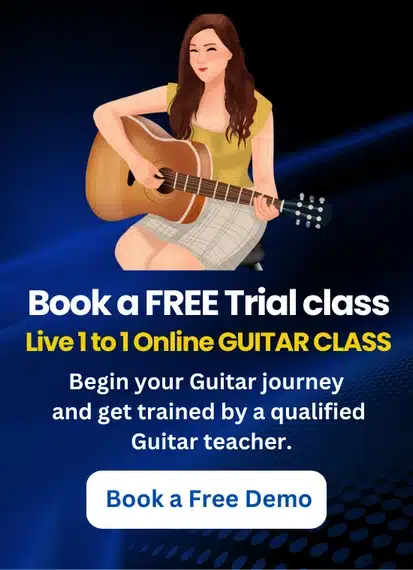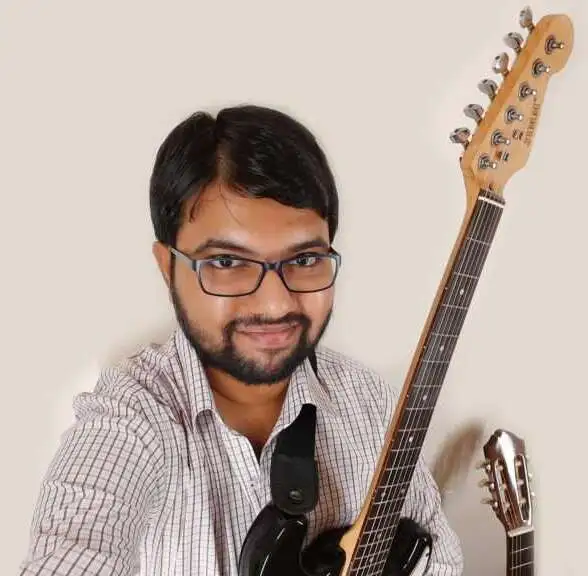The E Major scale on guitar is one the most frequently used scale in a lot of songs. This is a major scale that begins with the root note E and has four sharps (#) in it’s key signature. The relative minor for the E major key is C# minor. Since the E major scale on guitar also involves the use of many open position chords, this scale is also practically applicable in many popular songs you may already know or have heard of. This blog will guide you on different e major scale guitar songs along with e major scale guitar all playing positions.
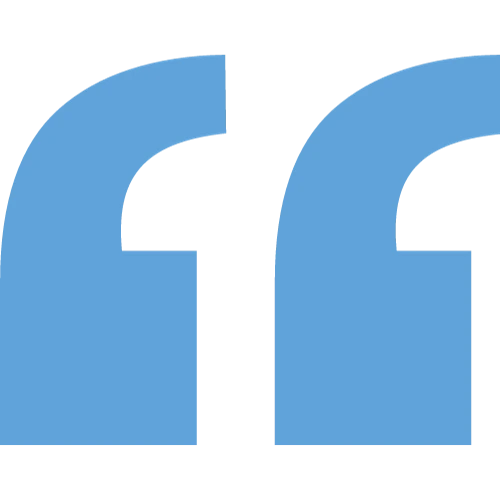
The sound of music fills the air when guitar strings strum, weaving together the whispers of one’s thoughts into a symphony of feelings.
Songs In E Major Scale on Guitar
There are many famous German composers like Johann Sebastian Bach, Ludwig van Beethoven and Frédéric Chopin who have created many significant compositions/concertos in the key of E major during the baroque period (sometime in the 17th century).
This four-sharp major key is notably used in various modern-day popular songs like Slow Dancing In A Burning Room by John Mayer, My Heart Will Go On by Céline Dion, Hey Soul Sister by Train, Photograph by Ed Sheeran, Red by Taylor Swift, Fast Car by Tracy Chapman, Pour Some Sugar On Me by Def Leppard, Always by Bon Jovi, Through The Trees by Wildling and Take You With Me by Tremonti.
What Notes Are In The E Major Scale Guitar?
In order to understand the notes in the E major scale on guitar, you need to know the intervals of the major scale formula. These are the distances between any two given notes on fret-board. They can have either a fret between them or not. Based on this, they are classified as tones and semi-tones. The major scale formula is tone, tone, semi-tone, tone, tone, tone, semi-tone or TTSTTTS for short.
The notes in the E Major scale are E F# G# A B C# D#. So, start by playing the root note on the open 1st string (E). The next note is a semi-tone away. So, hold down the string at the 2nd to play the next note. The note after F# is G#, which is a tone higher. So play G# on the 4th fret. The next note is a semi-tone apart. So, play A at the 5th fret. The following three notes have the same intervals. So play B, C# and D# on the 7th, 9th and 11th frets respectively. Finally, play the last note on the 12th fret, which is the root note as well (E).

As is the case with all major scales, the 3rd and 4th notes and the 7th and 8th e major scale notes have the same interval – a semi-tone. This means these two sets of notes are also the closest to each other. This may come in handy next time you try to recall the notes in the e major. You may also refer to the tablatures below to play the notes in the E major scale.

Now, let’s see how to properly play the E major scale notes on guitar involving two octaves.
E Major Scale Guitar All Positions
1. Open Position

To play the e major scale notes in the open position, keep your fretting hand near the guitar nut to facilitate the use of your pointer, middle and ring fingers to play the notes on the 1st, 2nd and 4th frets across all the strings. Look at the tablatures provided below. They have italic numbers at the top. These numbers represent the fingers to be used to play the scales. Here’s what they stand for:
1 – pointer/index finger 2 – middle finger
3 – ring finger 4 – little finger

The following scale positions are all decided based on the CAGED system i.e., where the E major chord can be played in the shape of the five basic open chords (including E major).
2. Fourth Position
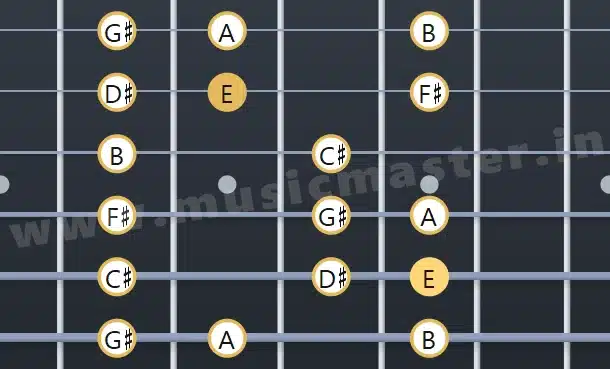
All the e major scale notes in the fourth position are within the 4th and 7th frets. Naturally, to play these notes, you need to shift your fretting hand between the 4th and 7th frets. Utilise your pointer, middle, ring and little fingers to play the notes on the 4th, 5th, 6th, and 7th frets respectively. The root notes are located at the 7th fret on the 5th string and the 5th fret on the 2nd string. See the tablatures below to guide you through playing the scale of e major in the fourth position.
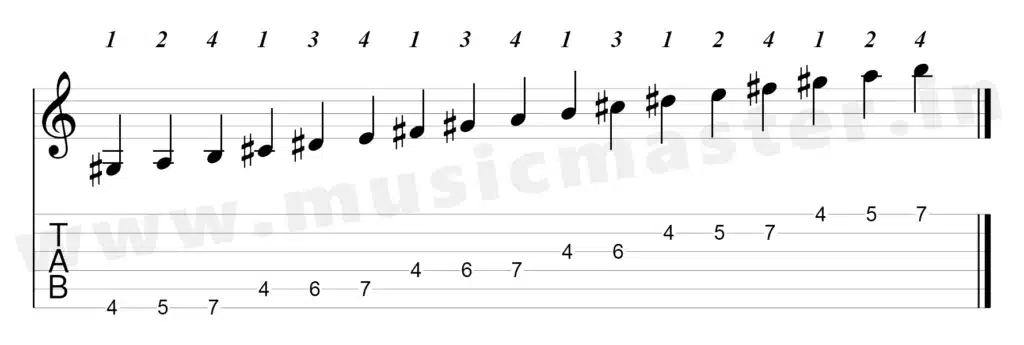
3. Fifth Position
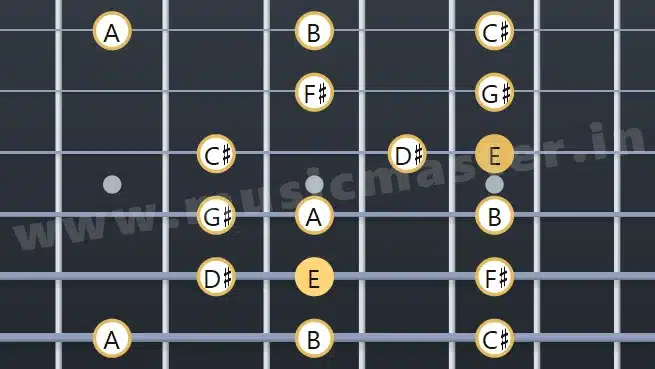
This e major scale position involves notes played from the 5th fret to the 9th fret. So, this scale position involves a lot of stretching by the fretting hand to enable the little finger to access the notes on the 9th fret of the guitar, especially on the 6th and 1st strings. Bring your fretting hand between the 5th and 9th fret. Play the notes on the 5th and 6th frets with your index finger. For the notes on the 7th, 8th and 9th frets, use the middle, ring and little fingers. Refer to the tablatures below with finger numbers on top to guide you through the fifth position of the E major scale.
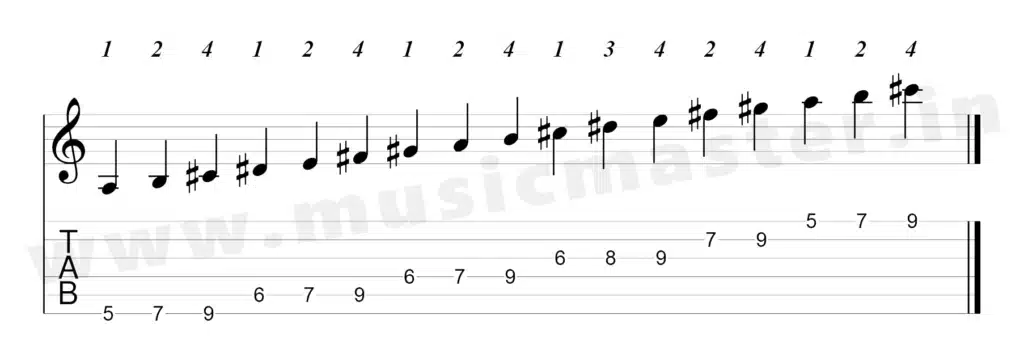
4. Ninth Position
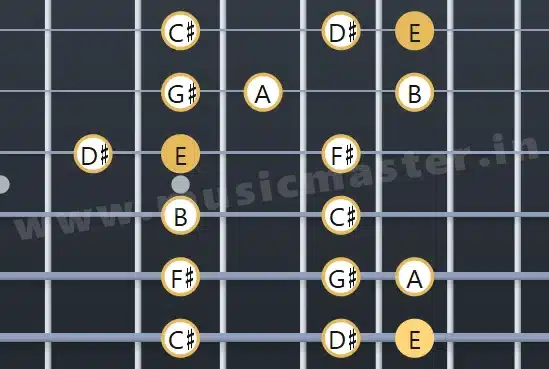
The ninth position of the E major scale on guitar contains all the notes in the scale in two octaves. For the ninth position of the E major scale, move your fretting hand towards the 9th fret of the guitar to play all the notes on the 9th, 10th, 11th, and 12th frets with your index, middle, ring and little fingers respectively. Just for the notes on the 3rd string, move your fretting hand down by one fret to use your pointer, middle and little fingers to play the notes on the 8th, 9th and 11th frets. Tablatures with finger numbers are provided below for your reference.
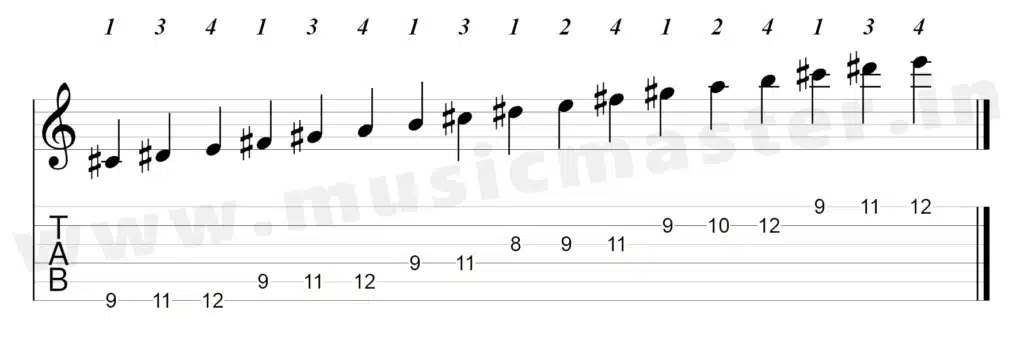
5. Eleventh Position

The eleventh position of the E major scale on guitar also has the same notes in the same octaves as the previous scale of e major position. The difference is in what note these scale positions start and end with and the positions themselves. As the name suggests, the eleventh position of the E major scale notes starts at the 11th fret of the guitar. So, it would be wise to keep your fretting hand between the 11th and 14th frets of the guitar. This way, you can play all the notes on the 11th, 12th, 13th and 14th frets with your index, middle, ring and pinkie fingers. Refer to the tablatures below with finger numbers italicised for your convenience.

6. Twelfth Position
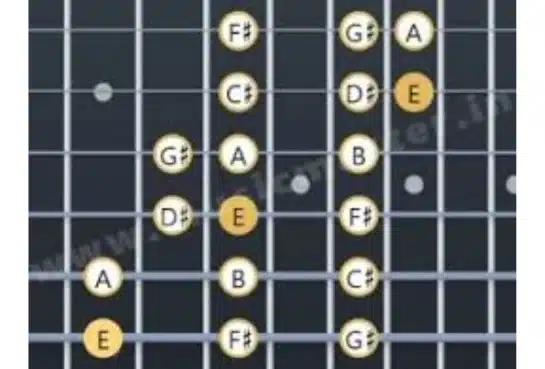
The last playable scale position (based on the CAGED system) of E major scale also has the same notes in the same octaves as the previous two scale positions. This scale position starts at the 12th fret and goes all the way to the 17th fret. For the 6th and 5th strings, use your pointer, middle and little fingers to play the notes at the 12th, 14th and 16th frets.
For the next 6 notes, move your fretting hand up by one fret to use the same three fingers to play the notes at the 13th, 14th, and 16th frets on the 4th and 3rd strings. Now, for the last 6 notes, move your fretting hand up by a fret again to use the pointer, ring and little fingers to play them at the 14th, 16th and 17th frets on the 2nd and 1st strings. Follow the tablatures below with finger numbers labelled at the top of the score.

It’s always a good practice to play each of these scale positions in both ascending and descending orders. All the scale positions above are in ascending order starting from the lowest sounding note to the highest one (in pitch). So, try playing them from the highest note on the 1st string and play all the notes one by one in reverse order until you reach the lowest note on the 6th string.
Now you know the notes in the E major scale. These notes can be used to create the various E major chord that listed below, here’s how you can make these chord:
The E Major Chord
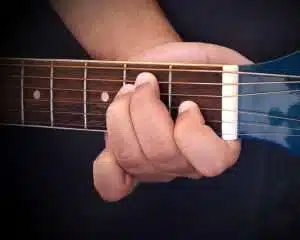
E major chord is played by combining three distinct notes in various pitches taken from the E major scale. The E major triad is formed by purely playing these three notes from the scale. If you recall, a triad is a three-note chord combination of the 1st, 3rd and 5th notes of the respective major/minor scale.

Did You Know?
Have you ever considered that learning the E scale is crucial, for guitar players? Getting a grasp of this scale not enhances finger agility but also serves as the basis for performing numerous tunes and solos across different music styles. Whether you’re just starting out. Have some experience, with the guitar mastering the E major scale unlocks a new realm of musical exploration on the fretboard.
So, to make the E major triad, just take the 1st, 3rd and 5th notes of the E major scale. These notes are E, G# and B. To play the E major triad on the top three strings, just push down the 3rd string at the 1st fret with your pointer as shown in the chord diagram below. Leave the 2nd and 1st strings open. Now, with your picking hand, strum the top three strings.
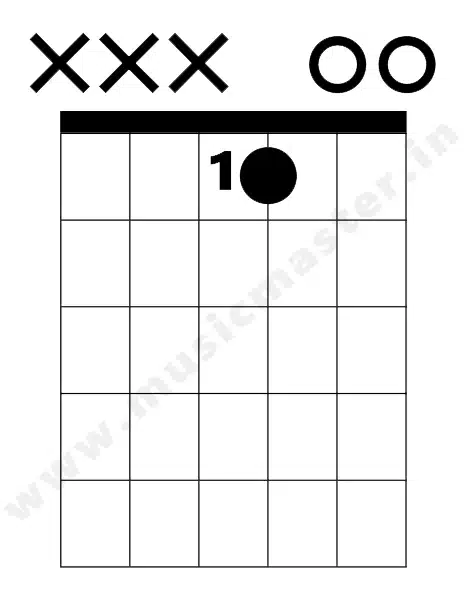
To play the full version of the E major chord in the open position, start by bringing your pointer to hold down the 3rd string at the 1st fret. Now, fold your middle and ring fingers and push them down on the 5th and 4th strings respectively at the 2nd fret. Be sure not to mute the 3rd string with your ring finger. Leave the 6th, 2nd and 1st strings open. Now, with your picking hand, strum all 6 strings together. You may refer to the chord diagram below to guide you to hold the E major chord.

Practice strumming this chord a few times without creating any muted or buzzing sounds. If you’re successful, you may try out the following chords which are all related to the E major key.
What Chords are in E Major Scale?
1. F# MINOR
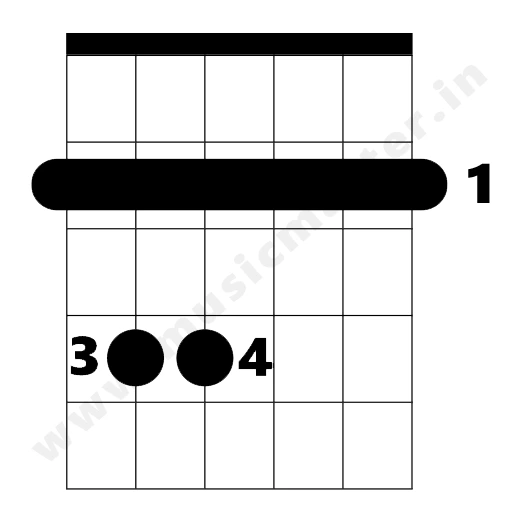
The F# minor is often combined with the E major chord in most songs in the E major key. It’s triad includes the notes F#, A and C#. It is the relative minor of the A major key. The easiest way to play this chord is by holding the shape of the E minor chord on the 5th and 4th strings at the 4th fret and with a barre hold on the 2nd fret using the pointer finger to enable the use of the root note (F#) located at the 2nd fret on the low E string.
2. G# MINOR
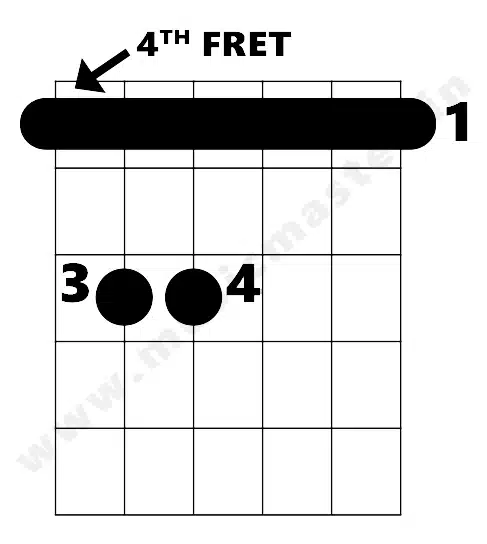
Usually played as a barre chord starting on the 4th fret, the G# minor chord is also often played along with the E major chord progressions. The chord triad of G# minor has the notes G#, B and D#, which can be played on the 4th, 3rd and 2nd strings in an open position. But, in order to play the full chord, it has to be played as a full barre chord starting on the 4th fret in the same chord shape as the F# minor. All you need to do is shift the fretting hand (with the fingers holding the same chord shape) up by two frets.
3. A MAJOR
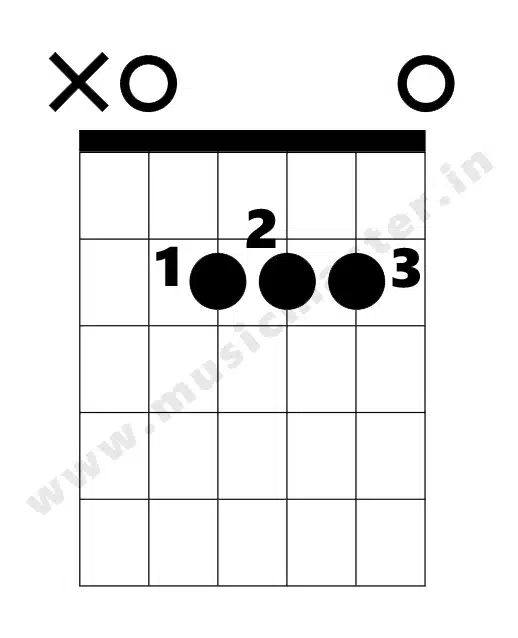
This is One of the basic open chords as part of the CAGED chords. The A major chord is quite frequently played along with the E major chord in songs written in the E major key. It’s triad is made up of the notes A, C# and E. To play the A major chord, hold down the 4th, 3rd and 2nd strings at the 2nd fret with your index, middle and ring fingers respectively. Leave the 5th and 6th strings open. With your picking hand, strum from the 5th string to the 1st string. Don’t touch the 6th string.
4. B MAJOR

Here’s another popularly used chord. The B major is the relative major of F# minor. It is primarily made up of three distinct notes (taken from the triad ) – B, D# and F#. It’s chord shape is derived from the A major chord’s open position. To hold this chord shape, start by barring the 2nd fret with your first finger. Now, squeeze your middle, ring and little fingers and place them on the 4th, 3rd and 2nd strings at the 4th fret. With your picking hand, strum from the 5th string all the way to the 1st string.
5. C# MINOR
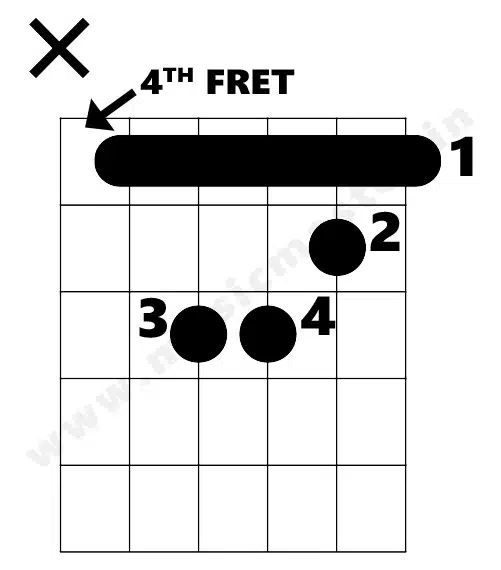
The C# minor is justifiably one of the most commonly played chords in any song in the key of E major since it is the relative minor of E major. The C# minor triad has the notes C#, E and G#. The chord shape commonly held for this chord resembles the A minor open chord. To play C# minor, start by barring all the strings at the 4th fret. Next, push down the 4th and 3rd guitar strings at the 6th fret using your ring and pinkie fingers respectively. Finally, add your middle finger on the 2nd string at the 5th fret. Now, with your picking hand, strum from the 5th string, leaving the 6th string untouched.
6. D# DIMINISHED
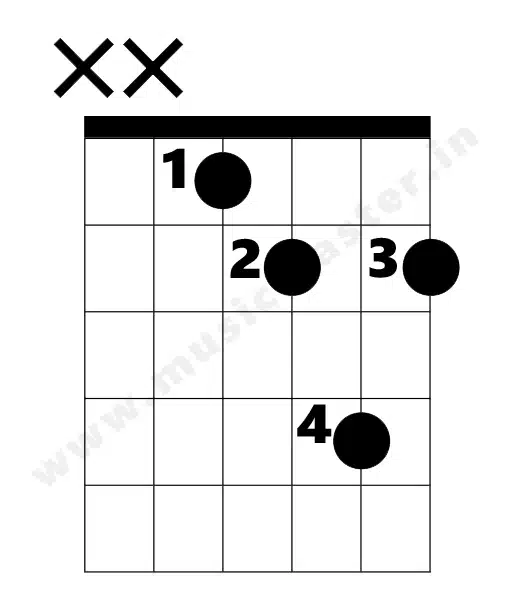
This may be an unheard-of chord name. Most diminished chords are rarely used. Yet, it is vital to learn the D# diminished chord as it is one of the relative chords in the E major key. It’s triad consists of the notes D#, F# and A. All diminished chords are created by the 3 notes of their corresponding major scales by flattening the 3rd and 5th notes by a semi-tone. It is often represented with a ° symbol.
To play the D# diminished chord within the first few frets, start by placing your index finger on the 4th string at the 1st fret. Next, push down the 3rd string at the 2nd fret with your middle finger. Now, stretch your little finger really far to hold down the 2nd string at the 4th fret. While keeping your little finger outstretched, try to push the 1st string down with your ring finger at the 2nd fret. Strum from the 4th string to the 1st string, ignoring the 6th and 4th strings. Keep repositioning your fingers until you can play it cleanly, without any unwanted buzzing or muted sounds.
Some of these chords may not be easy to hold down and strum. At first, try holding down each chord with your fretting hand and pick each note one by one until all the notes sound clean and bright, without any buzzing or muted sounds. Once you’re good at that, try switching between different chords.
Also practice all these chords with some strumming exercises along with a metronome. Start at really slow speeds like 50-60 BPMs. Gradually increase the tempo by 5 or 10 BPMs until you can comfortably play a couple of these chords effortlessly and transition between them smoothly.
Want to improve your Guitar playing skills? Learn to play following Guitar Scales.
Your complete handbook, for mastering the art of playing melodious tunes. Immerse yourself in this guide to enhance your guitar abilities and enrich your collection.





